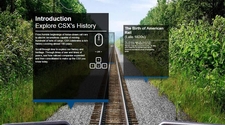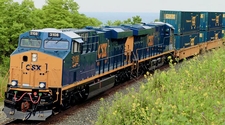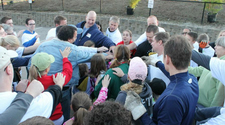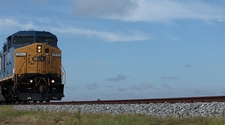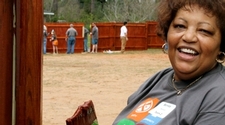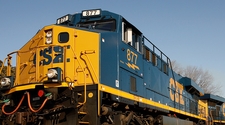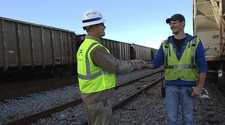| Hack (Slang) |
See Caboose. |
| Hand Brake |
The brake apparatus used to manually apply the brakes on a car or locomotive. |
| Haulage Rights |
Rights obtained by one railroad to have its trains operated by another railroad over that railroad?s tracks. |
| Hazardous Material (AKA Hazmat) |
A substance or material, which is capable of posing an unreasonable risk to health, safety, and the environment. |
| Head Block |
The fixed signal at the entrance to a segment of Absolute Permissive Block territory, indicated by a Block-Limit Signal. |
| Head End |
Beginning or forward portion of any train. |
| Head Man |
Brakeman responsible for work done in connection with the forward section of the train and, when in transit, is stationed in the locomotive. |
| Head of Train Device (HTD) |
An appliance in the locomotive cab that receives information from the End of Train Device (ETD) and provides a readout to the engineer. See Receiver Display Unit. |
| Head Pin (Slang) |
See Head Man. |
| Header |
Beginning or identifying portion of any list or consist. |
| Heater (Switch) |
A device for melting snow at switches by means of steam, an electric current, gas jets, or oil. |
| Heater Car |
An insulated box car equipped with heating apparatus for the protection of commodities that are liable to be damaged by cold weather. |
| Heavy OK |
Term used to indicate that repairs have been completed for a car which was classified as a heavy repair. |
| Heavy Repairs |
As reported to the AAR, repairs to revenue freight cars requiring over 20 man-hours. |
| Held-For-Billing |
Term used to designate a car in the yard for which there is no waybill or forwarding instructions. |
| Helper Engine |
A manned locomotive used to assist in the movement of a train. |
| Helper Link |
A device added to a helper locomotive, which communicates brake pipe pressure via a radio signal between the two-way end-of-train device and the helper locomotive. It eliminates connecting the brake pipe between the helper locomotive and the rear of the train, enabling them to detach without stopping. |
| Hi-Cube Car |
A box car of approximately 85 ft. in length and 10,000 cu. ft. in capacity designed for hauling automobile body stampings and other low density freight. |
| High Adhesion Locomotive |
A type of locomotive that allows locomotive wheels to turn slightly faster than the locomotive is actually moving, in an effort to gain adhesion, which in turn, allows higher tractive effort to be generated. |
| High and Wide Car |
Car of excessive dimensions which must be handled with special care and attention to clearances. |
| High Iron |
Main line or high speed track. |
| High Rail |
The outer or elevated rail of a curved track. OR The inspection of a section of railroad using a highway vehicle equipped with rail wheels. |
| High-Side Gondola Car |
A gondola car with sides and ends over 36 inches in height. |
| High-Wide |
A car that exceeds dimension restrictions due to its construction or due to the size of its load. It requires special handling. |
| Highball (Slang) |
Signal to proceed at maximum authorized speed, given by hand or by lantern in a high, wide semi-arc. |
| Highway Crossing at Grade |
A location where streets or highways cross over railroad tracks. |
| Historical Rates |
Expired rate information, including the adjustments to specific prices and the rates resulting from each adjustment. |
| Hog (Slang) |
Locomotive or locomotive engineer. |
| Hog Law (Slang) |
The Federal statute which provides that all train and engineer crews must be relieved of duty after 12 hours of continuous service. |
| Hogger (Slang) |
Locomotive engineer. |
| Hoghead (Slang) |
Locomotive engineer. |
| Hold Point |
Point specifically named in tariffs, contracts, etc. where cars may be stopped and held awaiting delivery or reconsignment instructions. |
| Hold-for-Billing |
See Held for Billing. |
| Holding Tracks (Yard) |
Tracks upon which locomotives and cars may be held to await disposition of orders. |
| Hole |
Term applied to siding which one train pulls into when it meets another. |
| Home |
A location where a car is on the tracks of its owner. |
| Home Car |
A car on the tracks of its owner or lessee. |
| Home Junction |
A junction with the home road of a railroad. |
| Home Road |
Used in connection with car service to denote the road that is the owner or lessee of the car, or upon which the home of a private car is located. |
| Home Route |
The return route of a foreign empty car to the owning road. |
| Home Signal |
A fixed signal governing the entrance to an interlocking. |
| Hook |
Wrecking derrick. OR To hook/couple/hitch cars, engines or equipment together. |
| Hopper Car |
A car with a sloping floor which will discharge its load by gravity through the hopper doors. |
| Hostler |
A fireman who operates light engines in designated engine house territory and works under the direction of the engine house foreman. |
| Hostler's Control |
A simplified throttle provided to move the "B" unit of a diesel locomotive not equipped with a regular engineer's control. |
| Hot Box |
An overheated journal caused by excessive friction between bearing and journals due to lack of lubricant or presence of foreign matter. |
| Hot Box Detector |
A wayside infrared sensing instrument used to identify overheated journal bearings. |
| Hot Box Signal |
Holding the nose with one hand and pointing to the wheels with the other. |
| Hot Rail |
An expression used as a warning that a movement is closely approaching on a nearby track. |
| Hot Shot |
A fast train of any class, sometimes known as a highball run. |
| Hours of Service Law (AKA Hog Law) |
The Federal statute which provides that all train and engineer crews must be relieved of duty after 12 hours of continuous service. |
| House Track |
A track alongside or entering a freight house, used for cars delivering, receiving, or transferring freight. |
| Hump |
That part of a track which is elevated so that when a car is pushed over it and uncoupled, the car rolls down the other side by gravity. |
| Hump Yard |
A switching yard with an elevated track or hump over which cars are pushed by a switch engine so that they travel by gravity to classification tracks. |
| back to top |


